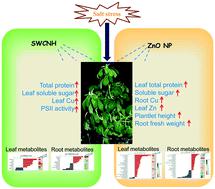当前位置:
X-MOL 学术
›
Environ. Sci.: Nano
›
论文详情
Our official English website, www.x-mol.net, welcomes your
feedback! (Note: you will need to create a separate account there.)
Comparative physiological and metabolomics analysis reveals that single-walled carbon nanohorns and ZnO nanoparticles affect salt tolerance in Sophora alopecuroides
Environmental Science: Nano ( IF 5.8 ) Pub Date : 2020-08-17 , DOI: 10.1039/d0en00582g Jinpeng Wan 1, 2, 3, 4 , Ruling Wang 1, 2, 3, 4 , Hanrui Bai 1, 2, 3, 4 , Yibo Wang 4, 5, 6, 7, 8 , Jin Xu 4, 5, 6, 7, 8
Environmental Science: Nano ( IF 5.8 ) Pub Date : 2020-08-17 , DOI: 10.1039/d0en00582g Jinpeng Wan 1, 2, 3, 4 , Ruling Wang 1, 2, 3, 4 , Hanrui Bai 1, 2, 3, 4 , Yibo Wang 4, 5, 6, 7, 8 , Jin Xu 4, 5, 6, 7, 8
Affiliation

|
Salt stress, which is one of the limiting factors for crop yield and quality, has received more attention with increasing salinization worldwide. Here, we showed that changes in metabolomic profiling by single-walled carbon nanohorns (SWCNHs) and ZnO nanoparticles (ZnO NPs) contributed to salt tolerance in Sophora alopecuroides seedlings. Compared with untreated control plants, foliar spraying with SWCNHs increased the root length, root fresh weight and leaf soluble sugar content, while ZnO NPs increased the root fresh weight, leaf dry weight and soluble sugar content, indicating that the two engineered nanomaterials (ENMs) improved the growth of S. alopecuroides seedlings. Under salt stress, foliar spraying with SWCNHs increased the PSII activity, total protein contents of leaves and roots, leaf soluble sugar content and copper (Cu) content in the leaves, while ZnO NPs increased the plantlet height, root fresh weight, leaf total protein content, soluble sugar contents of leaves and roots, leaf zinc (Zn) content and root Cu content, thereby improving the salt tolerance of S. alopecuroides seedlings. Metabolome analysis further supported the notion that the two ENMs contributed to salt tolerance by reprogramming the carbon/nitrogen metabolism and promoting glycolysis and the TCA cycle to generate energy and increasing the levels of unsaturated fatty acids to maintain membrane integrity under salt stress. Furthermore, we revealed that, although both SWCNHs and ZnO NPs improved salt tolerance in S. alopecuroides seedlings, there were both similar and distinct mechanisms for the two ENMs in modulating plant growth and stress response. Under salt stress, the accumulation of metabolites in the leaves and roots of ZnO NP-treated plants was 4.83 fold and 3.7 fold higher than those in SWCNH-treated plants, respectively, suggesting a better effect of ZnO NPs in modulating the salt tolerance in S. alopecuroides seedlings than SWCNHs. Taken together, these results suggested that the application of the two ENMs provided a novel way to improve salt tolerance in plants.
中文翻译:

生理和代谢组学的比较分析表明,单壁碳纳米角和ZnO纳米颗粒会影响槐豆的耐盐性
盐胁迫是作物产量和品质的限制因素之一,随着全球盐碱化程度的提高,盐胁迫受到了越来越多的关注。在这里,我们显示了单壁碳纳米角(SWCNHs)和ZnO纳米颗粒(ZnO NPs)的代谢组学谱变化有助于槐豆幼苗的耐盐性。与未处理的对照植物相比,SWCNHs的叶面喷洒增加了根长,根鲜重和叶片可溶性糖含量,而ZnO NPs则增加了根鲜重,叶片干重和可溶性糖含量,表明这两种工程纳米材料(ENMs)改善了苦瓜链霉菌的生长幼苗。在盐胁迫下,SWCNHs叶面喷施可增加PSII活性,叶片和根部的总蛋白质含量,叶片中的可溶性糖含量和叶片中的铜(Cu)含量,而ZnO NPs可增加植株高度,根鲜重,叶片总蛋白含量,叶和根的可溶性糖含量,叶锌(Zn)含量和根铜含量,从而提高了苦豆根的耐盐性幼苗。代谢组学分析进一步支持了以下观点:两个ENM通过重新编程碳/氮代谢并促进糖酵解和TCA循环以产生能量并增加不饱和脂肪酸的水平来维持盐分胁迫下的膜完整性,从而提高了盐分耐受性。此外,我们发现,虽然两者SWCNHs和ZnO纳米粒子改善了耐盐性S.豆子苗,有用于调节植物生长和胁迫应答两个ENMS相似和不同的机制。在盐胁迫下,ZnO NP处理过的植物的叶片和根部代谢产物的积累分别比SWCNH处理过的植物高4.83倍和3.7倍,这表明ZnO NPs在调节盐胁迫方面具有更好的效果。S. alopecuroides幼苗比SWCNHs。综上所述,这些结果表明两种ENM的应用提供了提高植物耐盐性的新颖方法。
更新日期:2020-10-17
中文翻译:

生理和代谢组学的比较分析表明,单壁碳纳米角和ZnO纳米颗粒会影响槐豆的耐盐性
盐胁迫是作物产量和品质的限制因素之一,随着全球盐碱化程度的提高,盐胁迫受到了越来越多的关注。在这里,我们显示了单壁碳纳米角(SWCNHs)和ZnO纳米颗粒(ZnO NPs)的代谢组学谱变化有助于槐豆幼苗的耐盐性。与未处理的对照植物相比,SWCNHs的叶面喷洒增加了根长,根鲜重和叶片可溶性糖含量,而ZnO NPs则增加了根鲜重,叶片干重和可溶性糖含量,表明这两种工程纳米材料(ENMs)改善了苦瓜链霉菌的生长幼苗。在盐胁迫下,SWCNHs叶面喷施可增加PSII活性,叶片和根部的总蛋白质含量,叶片中的可溶性糖含量和叶片中的铜(Cu)含量,而ZnO NPs可增加植株高度,根鲜重,叶片总蛋白含量,叶和根的可溶性糖含量,叶锌(Zn)含量和根铜含量,从而提高了苦豆根的耐盐性幼苗。代谢组学分析进一步支持了以下观点:两个ENM通过重新编程碳/氮代谢并促进糖酵解和TCA循环以产生能量并增加不饱和脂肪酸的水平来维持盐分胁迫下的膜完整性,从而提高了盐分耐受性。此外,我们发现,虽然两者SWCNHs和ZnO纳米粒子改善了耐盐性S.豆子苗,有用于调节植物生长和胁迫应答两个ENMS相似和不同的机制。在盐胁迫下,ZnO NP处理过的植物的叶片和根部代谢产物的积累分别比SWCNH处理过的植物高4.83倍和3.7倍,这表明ZnO NPs在调节盐胁迫方面具有更好的效果。S. alopecuroides幼苗比SWCNHs。综上所述,这些结果表明两种ENM的应用提供了提高植物耐盐性的新颖方法。











































 京公网安备 11010802027423号
京公网安备 11010802027423号